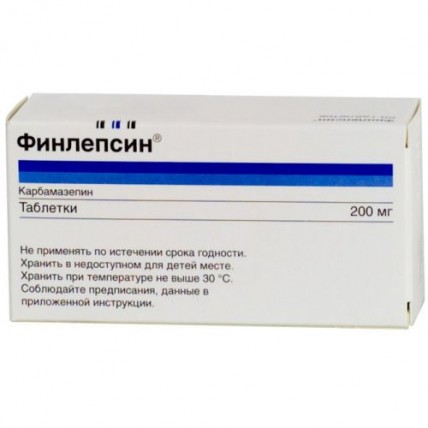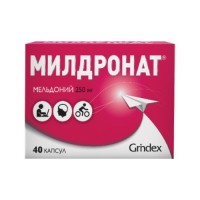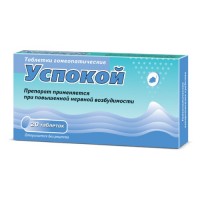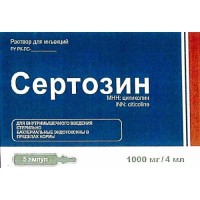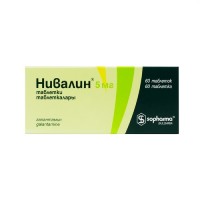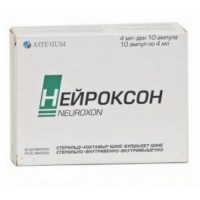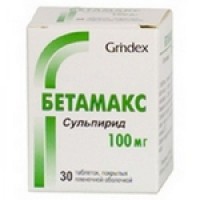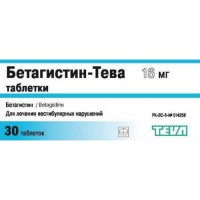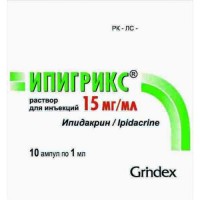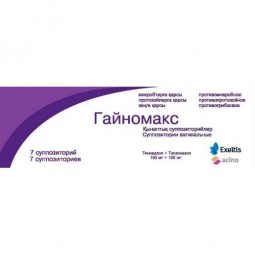Finlepsinum 200 mg (50 tablets)
- $24.60
The instruction for medical use
of medicine
Finlepsinum
the Trade name
Finlepsinum
the International unlicensed
name Carbamazepine Dosage Form
of the Tablet of 200 mg
Structure
One tablet contains
active agent - carbamazepine of 200 mg,
excipients: microcrystalline cellulose, gelatin, sodium of a kroskarmelloz, magnesium stearate.
The description
of the Tablet of round shape of white color, with a convex surface on one party, with a facet and risky in the form of wedge-shaped deepening - on the other hand.
Pharmacotherapeutic group
Antiepileptic drugs.
Derivatives of a karboksamid. Carbamazepine.
The ATX N03AF01 code
the Pharmacological
Pharmacokinetics At properties intake varies the speed of absorption of carbamazepine at different patients though finally drug is soaked up completely. The absolute bioavailability of carbamazepine is in limits of 85-100%. The maximum concentration in plasma is reached on average in 12 hours after reception. After a single dose of 400 mg the average value of peak of concentration in plasma of not changed carbamazepine is about 4.5 mkg/ml. Steady concentration of carbamazepine in plasma is reached within 1-2 weeks. However it has individual character and depends on activity of microsomal enzymes, the status before treatment, a dosage and duration of therapy.
Carbamazepine for 70-80% contacts proteins of plasma. Concentration of not changed substance in cerebrospinal liquid and in saliva reflects the size of an untied portion in plasma (20-30%). Concentration in breast milk is equivalent to 25-60% of appropriate levels in plasma. Carbamazepine passes through a placental barrier. In view of full absorption of carbamazepine, level of distribution fluctuates ranging from 0.8 up to 1.9 l/kg.
Carbamazepine is metabolized in a liver with formation of a 10.11-dihydroxy-derivative and its glucuronide as the main metabolites. Dihydroxy derivative is formed through a mode of formation of stable epoxide (carbamazepine-10.11-epoxide) which has anticonvulsant activity. In transformation of carbamazepine to 10.11 epoxide of carbamazepine the main isoform of P450 3A4 cytochrome is responsible. Inactive metabolites (9-hydroxy-methyl-10-karbamoil acridone, monohydroxylated components, a carbamazepine N-glucuronide) are formed also pharmacological.
Steady therapeutic concentration of carbamazepine in plasma, has significant individual fluctuations. It is considered that for most of patients it is in limits of 4-12 mkg/ml that corresponds to 17-50 µmol/l. Concentration of 10.11-epoxide-carbamazepine makes about 30% of level of carbamazepine in plasma.
Elimination half-life of not changed carbamazepine averages 36 hours, and 10.11 epoxide of a metabolite - about 6 hours after a single dose of drug. Due to the ability of carbamazepine to induce activity of microsomal enzymes of a liver at constant reception the elimination half-life it decreases and averages 16-24 hours. At the patients receiving the accompanying therapy by other enzimindutsiruyushchy drugs (for example, Phenytoinum, phenobarbital), the determined elimination half-life averages 9-10 hours.
After single oral dose of 400 mg of carbamazepine of 72% (out of them 30% in a look epoxide metabolites) also 28% with excrements are brought with urine.
In kidneys about 2% are back soaked up in the form of not changed carbamazepine and about 1% in the form of pharmacological active 10.11 epoxide of a metabolite.
Features of pharmacokinetics at separate groups of patients.
At children, owing to faster elimination of carbamazepine, use Bol of high doses of drug at the rate on body weight kg, in comparison with adults can be required.
There are no data which would demonstrate that the pharmacokinetics of carbamazepine changes at patients of advanced age (in comparison with adult persons of young age).
Data on carbamazepine pharmacokinetics patients with renal failures or have no liver.
Pharmacodynamics
the Mechanism of effect of carbamazepine – active agent of Finlepsinum - is found out only partially. Carbamazepine stabilizes membranes of excessively excited nerve fibrils, inhibits emergence of repeated neuronalny categories and reduces synoptic carrying out exciting impulses. The main mechanism of effect of Finlepsinum is prevention of repeated education sodium – dependent action potentials in the depolarized neurons by means of blockade of natrium channels. Anticonvulsant effect of drug is generally caused by decrease in release of a glutamine and stabilization of membranes of neurons whereas the anti-maniacal effect can be caused by oppression of metabolism of a dopamine and noradrenaline.
As neurotropic means, Finlepsinum it is effective in a number of neurologic diseases. It prevents painful attacks in an idiopathic and secondary epileptiform neuralgia. At a syndrome of alcoholic abstinency Finlepsinum raises a threshold of convulsive readiness (which at this state is reduced) also the expressiveness of clinical manifestations of a syndrome, such as excitability, tremor, disturbance of gait reduces. At patients with not diabetes of the central genesis Finlepsinum reduces a diuresis and feeling of thirst.
Indications
For treatment:
Epilepsies:
- Simple partial attacks (focal epileptic seizures),
- Difficult partial attacks (psychomotor epileptic seizures),
- epilepsy Attacks, in particular focal character (night epilepsy, diffusion epilepsy),
- the Mixed epilepsy forms
- Trigeminal neuralgia
- Genuinical glossofaringealny neuralgia
- Painful diabetic neuropathy
- Neepileptichesky attacks at the people suffering from a multiple sclerosis, for example, as trigeminal neuralgia, tonic attacks, a paroxysmal dysarthtia, and pain attacks
- Prevention of attacks at a hungover syndrome
the Route of administration and doses
In each separate case, treatment by Finlepsinum has to begin individually, depending on type and degree of gravity of a clinical picture, and further, a dose it is necessary to raise slightly for achievement of the most effective maintenance dose.
The daily dose usually is ranging from 400 up to 1200 mg of carbamazepine. As a rule, the general day dose should not exceed 1600 mg of carbamazepine as high doses lead to emergence of bigger number of side effects.
In some cases, the necessary dose can significantly differ from the initial and supporting shown dose (perhaps, because of the strengthened metabolism caused by enzyme induction or interaction with other drugs at the combined treatment).
At treatment of epilepsy, Finlepsinum preferably has to be used separately (monotherapy). Upon transition to Finlepsinum, the dose of earlier used antiepileptic drug has to be reduced gradually.
At treatment of epileptic convulsive seizures, the following general regime of dosing is recommended:
An initial day dose
the Day maintenance dose
Adult
200 mg once a day
200-400 mg three times a day
Children *
1 – 5 years
of 100 mg one - twice a day
200 mg one - twice a day
6 – 10 years
of 100 mg twice a day
200 mg three times a day
11 – 15 years
of 100 mg two-three times in day
of 200-400 mg three times a day
or
200 mg three – five times a day
* Notes:
Clinical experience recommends to begin with a day dose 20-60 mg at treatment of children under 4 years. This day dose can increase every day by 20-60 mg of carbamazepine until theoretically required dose is reached. Nevertheless, the above-stated doses should not be exceeded.
On the basis of clinical experience, the initial dose in 100 mg can be used at treatment of children 4 years are more senior. This day dose can raise every day or once a week on up to 100 mg of carbamazepine a day before achievement of theoretically required dose. Nevertheless, the above-stated ranges of doses should not be exceeded.
The following doses are recommended:
Epilepsy:
At treatment of adult patients, the initial dose making 1-2 tablets of Finlepsinum (that makes 200-400 mg of carbamazepine a day) has to raise gradually to a maintenance dose of 4-6 tablets of Finlepsinum (that is equivalent to 800-1200 mg of carbamazepine).
On average, the maintenance dose for children makes 10-20 mg carbamazepine/kg/day.
You see the recommended schemes of use above.
Trigeminal neuralgia, genuinical glossofaringealny neuralgia:
From the initial dose making 1-2 tablets of Finlepsinum (that is equivalent to 200-400 mg of carbamazepine) one or twice a day, the day dose increases by 2-4 tablets of Finlepsinum (that is equivalent to 400-800 mg of carbamazepine) until at the patient the pain does not disappear. In certain cases, treatment can be continued using the lowered maintenance dose making 1 tablet of Finlepsinum twice a day (that is equivalent to 400 mg of carbamazepine).
At treatment of elderly patients and patients with hypersensitivity, an initial dose ½ pill of Finlepsin is taken twice a day (that is equivalent to 200 mg of carbamazepine).
Painful diabetic neuropathy:
The average day dose makes one tablet of Finlepsinum three times a day (that is equivalent to 1200 mg of carbamazepine).
Not epileptic seizures
the Average day dose makes 1 tablet of Finlepsinum two-four times a day (that is equivalent to 400-800 mg of carbamazepine).
Prevention of attacks during hospital treatment of a hungover syndrome
the Average day dose makes 1 tablet of Finlepsinum three times a day (that is equivalent to 600 mg of carbamazepine). In serious cases, the dose can be increased in the first few days up to 2 tablets of Finlepsinum three times a day (that is equivalent to 1200 mg of carbamazepine).
Finlepsinum combination to sedative-somnolent drugs is not recommended. But, depending on clinical requirements, Finlepsinum can be combined with other drugs used at treatment of symptoms of a hungover syndrome.
Level of carbamazepine needs to be traced regularly. Attentive medical observation of the patient for identification of any side effects on central and the autonomic nervous system is recommended (see cancellation symptoms in the section "Side effects").
Note:
With diseases of a liver and kidneys and also to elderly patients lower doses are recommended to patients with serious cardiovascular diseases.
The type and a route of administration
of the Tablet divisible, are accepted in time or after a meal with a considerable volume of liquid (glass of water).
In certain cases it turns out that at division of a day dose into 4-5 separate doses the bigger effect is reached.
Duration of treatment depends on indications and individual reaction of the patient. The patient should not make the decision on the termination of administration of drug independently at all.
Duration of treatment changes depending on a case and is defined by the attending physician.
Antiepileptic treatment always is long-term. At treatment of epilepsy, such questions as stabilization and duration of treatment by Finlepsinum have to be solved individually experienced expert. The decision on reduction of a dose and the termination of administration of drug should not be accepted before at the patient attacks within two or three years stop.
For the treatment termination, it is necessary to reduce gradually a dose within a year or two years. At treatment of children, uses of a dose, perhaps otkhozhdeny from the scheme, depending on body weight instead of use of a dose according to their age though indicators of EEG should not worsen.
At treatment of neuralgia the continuation of treatment within several weeks with reception of a maintenance dose, for belief in absence of pain is enough. Existence of spontaneous regression came to light at careful reduction of a dose.
When resuming attacks of pain, treatment continued using a usual maintenance dose.
The same approach is applied at treatment of painful diabetic neuropathy and not epileptic seizures at a multiple sclerosis.
For prevention of attacks at treatment of a hungover syndrome, treatment by Finlepsinum needs to be stopped in 7-10 days by gradual lowering of a dose.
Side effects
When prescribing carbamazepine separately (as monotherapy), side effects were observed less than at its combination with other antiepileptic drugs (combination therapy).
Emergence of many side effects depends on a dose, in particular, in an initiation of treatment. Generally they disappear 8-14 days later after temporary lowering of a dose. Therefore, Finlepsinum initially has to be appointed in small doses, with the subsequent gradual increase to an optimum dose.
Central nervous system / mentality:
Very often:
- drowsiness, calm, somnolence, dizziness, ataxy (atactic and cerebellar disturbances).
Seldom:
- a depression or maniacal moods, phobic disorders, agressive behavior, the slowed-down thinking, a lack of energy, a hallucination (sound and visual), a ring in ears, a hyperacusia and a gipoakuziya and also changes in perception of music, latent psychosis.
At elderly patients:
- the headache and also confusion of consciousness and disturbing excitement, and patients with cerebral disturbances can be also observed diskinetichesky disorders, such as orofatsialny dyskinesia, choreoathetosis (involuntary movements in orofatsialny area, such as hyperkinesia, convulsions).
Very seldom:
- disturbances of the speech, dizesteziya, muscle weakness, polyneuropathy, peripheral neuritis and also partial paralysis of legs and flavoring disorders. Involuntary movements, such as asterixis or convulsive reductions, disturbances of ocular motor function with a nystagmus and/or doubling in eyes and also akkomodatsionny disturbances were observed less often.
There are certificates that carbamazepine can strengthen symptoms of a multiple sclerosis.
Cases of development of aseptic meningitis at treatment were reported by carbamazepine.
As well as other antikonvulsant, carbamazepine is capable to increase the frequency of attacks. In particular, absentias epileptica (special type of the attacks arising in both parencephalons) can become strengthened or arise anew.
Eyes:
- conjunctivitis, cataract, retinotoksichnost. At the treatment termination by carbamazepine, the state improved.
Musculoskeletal system:
- arthralgia, myalgia, muscular spasms. All of them passed after the termination of intake of carbamazepine.
Skin, mucous membranes, vascular system:
- allergic skin reactions with great feeling or without (urticaria or a skin itching), exfoliative dermatitis, an erythrosis, a Lyell's disease, photosensitivity, a mnogoformny exudative erythema, a knotty erythema, Stephens-Johnson's syndrome, a purpura and a disseminate lupus erythematosus, an alopecia, the increased sweating, change of xanthopathy, an acne, a hirsutism and a vasculitis were observed in separate or exceptional cases.
Blood and lymphatic system:
Very often:
- leukocytosis, eosinophilia, leukopenia, thrombocytopenia.
Very seldom:
- disturbances of a blood count which partially had deadly character (agranulocytosis, aplastic anemia and also other forms of anemia (hemolytic anemia, megaloblastichesky anemia), a reticulocytosis, a lymphadenopathy and a splenomegaly).
Digestive tract:
Often:
- loss of appetite, dryness in a mouth, nausea and vomiting.
Seldom:
- diarrhea and konstipation
Very seldom:
- an abdominal pain and inflammations of a mucous membrane in oropharyngeal area (stomatitis, an ulitis, a glossitis), pancreatitis.
Liver and gall bladder:
Seldom:
- yellowness, various types of hepatitis (cholestatic, hepatocellular, granulematozny, mixed).
Very seldom:
- acute, life-threatening hepatitis with a liver failure on the basis of an allergy, generally in the first several months of treatment.
- Metabolism (water and mineral balance), hormonic status:
Often:
- a hyponatremia which in rare instances caused a liquid delay in an organism, hypostases, increase in weight and the lowered osmolarity of plasma.
Seldom:
- water intoxication with vomiting, a headache, confusion of consciousness, a lethargy and other neurologic disturbances.
Very seldom:
- gynecomastia, a galactorrhoea, increase in level of cholesterol in serum, including the level of cholesterol of lipoproteins of high density and triglycerides and also free cortisol, lowering of the level of folic acid and B12 vitamin in blood serum, increase in level of a gomotsistein.
Carbamazepine is capable to lower calcium level in plasma, accelerating metabolism of cholecalciferol 25-OH. In some cases, it leads to osteomalacy.
There can be changes in function of a thyroid gland, in particular, at combination therapy with other antikonvulsant.
Also there are signs that at intake of carbamazepine in two cases strengthening of an intermittent porphyria was observed.
Bodies of a respiratory system:
- emergence of reactions of hypersensitivity in lungs with great feeling, short wind, and a pneumonitis or pneumonia (alveolitis) and pulmonary fibrosis.
Urinogenital ways:
Seldom:
- renal failures, proteinuria, hamaturia, oliguria
Very seldom:
- interstitial nephrite or renal failure and also other diseases of uric ways (dysuria, pollakiuria, ischuria).
Sexual dysfunction, for example, impotence and weakening of a libido, the lowered male fertility and/or abnormal spermogenez was also in some cases observed.
Cardiac vascular system:
Seldom:
- bradycardia and cardiac arrhythmia, coronary heart disease, heart failure, hypertensia, hypotension, thrombophlebitis and thrombembolia.
Reactions of hypersensitivity:
Seldom:
- heat, rash, vasculitis, increase in lymph nodes, joint pain, leukopenia, eosinophilia, increase in a liver and spleen, or change of indicators of functional trials of a liver.
Very seldom:
- allergic reactions, aseptic meningitis with a myoclonia, an eosinophilia, anaphylactic reactions and anginevrotichesky hypostasis.
Contraindications
- the known hypersensitivity to carbamazepine, excipients of drug or to tricyclic antidepressants
- disturbances of atrioventricular conductivity
- existence in the anamnesis of oppression of a marrowy hemopoiesis, an intermittent porphyria
- a combination with MAO inhibitors
- combinations with vorikonazoly.
Medicinal interactions
Treatment using monoamine oxidase inhibitors need to be stopped, at least, in two weeks prior to the beginning of a course of treatment Finlepsinum.
Influence of carbamazepine on concentration in plasma of other drugs:
Carbamazepine induces a system tsitokhrom-R-450 (mainly, CYPA isoenzyme) in this connection, concentration in plasma of the substances split by a system tsitokhrom-R-450 is reduced. Their doses can demand adjustment according to clinical requirements.
It works, for example, for the following drugs:
Other antikonvulsant (for example, clonazepam, Ethosuximidum, felbamat, Primidonum, lamotrigin, tiagabin, topiramat, valproic acid),
Benzodiazepines (alprazola, slobaza),
Typical neuroleptics (a haloperidol, bromperidol) and
Atypical neuroleptics (clozapine, olanzapine, risperidon, kvetiapin)
Tricyclic antidepressants (as, for example, Imipraminum, amitriptyline, nortriptilin, klomipramin),
Tetracyclines (as, for example, doxycycline),
Azolny antifungal drugs (for example, vorikonazol, itrakonazol as antifungal drugs can result in inefficiency of treatment),
the Praziquantel, kaspofungin, indinavir, fentanyl, midazolam, phenazone, methylphenidate, methadone, theophylline, kvanidin, digoxin, propanolol, felodipin, flunarizin,
Corticosteroids (for example, Prednisolonum, dexamethasone),
Cyclosporine, takrolimus,
Anticoagulants (for example, warfarin, fenprokumon, dikumarol)
Hormonal contraceptives.
At the patients accepting Finlepsinum, action of hormonal contraceptives can be lowered and intermenstrual bleedings can be observed. Therefore, oral contraceptives have to contain more than 50 mg of estrogen. Also use of some other, non-hormonal, contraception methods is recommended to patients.
Carbamazepine can both raise, and to lower concentration of Phenytoinum in plasma, in exceptional cases, it can cause a condition of confusion of consciousness, up to a coma.
Carbamazepine can lower the level of a bupropion in plasma and increase the level of its metabolite of a hydroksibupropion, thereby reducing clinical performance and reliability of a bupropion.
Carbamazepine can lower Trazodonum level in plasma, but at the same time, perhaps, strengthening its antidepressive action. Carbamazepine can accelerate metabolism of a zatepin.
The lowered concentration of carbamazepine in plasma:
Carbamazepine is metabolized by a system tsitokhrom-R-450 (mainly, CYP3A4 isoenzyme). Therefore, concentration of carbamazepine in plasma can be lowered by system inductors tsitokhrom-R-450, for example:
other antikonvulsant (phenobarbital, Phenytoinum, Primidonum, valproic acid), theophylline, rifampicin, doxorubicine, Cisplatinum, St. John's wort (Hypericum perforatum). On the other hand, level in plasma pharmacological of an active metabolite of carbamazepine-10.11-epoxide can be increased by valproic acid and also Primidonum.
At joint appointment with felbamaty, carbamazepine level in plasma can be lowered, and the level of carbamazepine-10.11-epoxide in plasma – is increased. Joint appointment can also cause the lowered felbamat level.
Taking into account these interactions of the drugs appointed in common, especially, in case of various anti-epileptic drugs, it is recommended to trace their level in plasma and, if necessary, to adjust Finlepsinum dose.
The increased concentration of carbamazepine in plasma:
Carbamazepine is metabolized by a system tsitokhrom-R-450 (mainly, CYP3A4 isoenzyme). Therefore, concentration of carbamazepine in plasma can be increased by system inhibitors tsitokhrom-R-450, for example, such as:
Makrolidny antibiotics (for example, erythromycin, troleandomitsin, dzhozamitsin, klaritromitsin), an isoniazid, antagonists of calcium (for example, verapamil, diltiazem), acetazoleamide, the dextropropoxyphene/propoxyhair dryer, viloksazin, danazol, ritonavir, azolny antifungal means (for example, itrakonazol, ketokonazol, flukonazol), niacinamide (in high doses for adult patients), fluoxetine, nefazodon, terfenadin, loratadin, Cimetidinum, perhaps, also desipramin and fluvoksamin.
The increased concentration of carbamazepine in plasma (and/or the level of carbamazepine-10.11-epoxide in plasma) can cause the symptoms specified in the section "Side effects" (for example, dizziness, fatigue, variability of gait, doubling in eyes). At emergence of such symptoms, it is necessary to check concentration of carbamazepine and, if necessary, to lower a dose.
Combined use of Finlepsinum and neuroleptics or Metoclopramidum can lead other forms of interaction to emergence of neurological side effects. Prescribing of Finlepsinum to the patients accepting neuroleptics can lower level in plasma of these drugs and, thereby, break a clinical picture. In this regard, dose adjustment of neuroleptics can be required.
Joint prescribing of lithium and carbamazepine can lead to strengthening of neurotoxic effects of both active ingredients. For this reason, it is necessary to control strictly level in blood of these drugs. In that case, patients should not accept neuroleptics during such treatment and within 8 weeks till its beginning. The following neurotoxic symptoms were observed: unstable gait, an ataxy, a horizontal nystagmus, the strengthened muscular proprioceptive reflexes, muscular twitchings (muscular fastsikulyation).
Finlepsinum is capable to strengthen hepatotoxic action of an isoniazid.
The combined intake of Finlepsinum and some diuretics (hydrochlorothiazide, furosemide) can cause a symptomatic hyponatremia.
Finlepsinum is capable to break efficiency of muscular relaxants, such as pankuronium, providing early removal of neuromuscular blockade. When prescribing Finlepsinum together with izotretinoiny (protivougrevy drug), it is necessary to control carbamazepine level in plasma.
Joint prescribing of Finlepsinum and paracetamol can lower bioavailability of paracetamol.
At gormonozamestitelny therapy at a hypothyroidism it is necessary to determine parameters of a thyroid gland at the beginning and the end of a course of treatment by Finlepsinum. If necessary, the dose of drugs of thyroid hormone has to be corrected. Function of a thyroid gland can be changed, in particular, at joint prescribing of carbamazepine and other antikonvulsant (for example, phenobarbital).
The combined prescribing of Finlepsinum and antidepressants – inhibitors of the return serotonin reuptake (for example, fluoxetine) can lead to emergence of a toxic serotoninovy syndrome.
Finlepsinum it is impossible to apply together with nefazodony (antidepressant) as Finlepsinum can cause significant lowering of the level of a nefazodon in plasma and, perhaps, total loss of efficiency. Besides, the concomitant use of a refazodon and Finlepsinum increases carbamazepine level in plasma and lowers level in plasma of its active metabolite of carbamazepine-10.11-epoxide.
Joint intake of carbamazepine and antiarrhytmic drugs, cyclic antidepressants or erythromycin increases risk of disturbance of warm conductivity.
As well as in a case with other psychoactive substances, carbamazepine can lower tolerance of alcohol at patients during treatment it is necessary to refrain from alcohol intake.
Special instructions
As carbamazepine can cause or aggravate absentias epileptica, the patients suffering from this type of attacks should not appoint Finlepsinum.
In the following cases it is necessary to appoint Finlepsinum only after careful weighing of benefits and risks and acceptance of all necessary precautionary measures:
- The previous or existing hematologic diseases or hematologic reactions to other drugs in the history of a disease of the patient
- the Broken sodium metabolism
- Serious violations of function of heart, liver and kidneys
- the Patients having miotonichesky dystrophy as disturbances of warm conductivity are typical for this group of patients.
Preventions and general notes:
- At treatment of children 6 years only after the careful analysis of benefits and risks are younger.
- At emergence of such symptoms as (pour) heat, a sore throat, skin allergic reactions with increase in lymph nodes and/or influenzal symptoms, it is necessary to see a doctor and to make blood test. In case of serious allergic reactions, treatment by Finlepsinum should be stopped immediately.
- Patients need to be warned that they should see immediately a doctor at emergence of symptoms of hepatitis, such as slackness, lack of appetite, nausea, yellowing of skin and increase in a liver.
- Leykotsitopeniya, thrombocytopenia
needs the Termination of treatment if these symptoms are followed by such complications as allergic symptoms, heat, a sore throat or skin bleedings.
- In view of the side effects and reactions of hypersensitivity given above, it is necessary to trace constantly a blood picture, function of kidneys and a liver, and carbamazepine level, in particular, at long-term treatment. At the combined treatment, it is necessary to keep track of concentration in plasma of other antiepileptic drugs and also, if necessary, to reduce day doses.
- It is recommended to check a picture of blood and characteristic of a liver prior to treatment by Finlepsinum. In the first month of treatment it is necessary to carry out such inspections weekly, then once a month. 6 months of treatment later, 2-4 checks a year can be sufficient.
- At patients with glaucoma it is necessary to check intraocular pressure regularly.
- At conversion of patients to other antiepileptic drugs, it cannot be done sharply. It is necessary to lower gradually a dose of Finlepsinum and to replace it with other antiepileptic drug.
Prevention: for prevention of attacks at a hungover syndrome, Finlepsinum always has to be accepted in hospital conditions.
Side effects of carbamazepine at treatment of a hungover syndrome can be similar to symptoms of refusal and can be easily confused with them.
In special cases if prevention of manic-depressive phases using only lithium is not rather effective and it is necessary to appoint Finlepsinum in combination with lithium, it is necessary not to allow undesirable interactions, watching that concentration of carbamazepine in plasma did not exceed permissible values (8 μг/мл), supporting lithium level in the low therapeutic range (0.3-0.8 mval/l), and having convinced that such treatment is not combined with purpose of any neuroleptics and that neuroleptics were not appointed within the last 8 weeks.
During treatment by carbamazepine, patients need to avoid intensive impact of sunlight as there is a risk of development of a photosensitization.
Short-term inspections (within a week) are required in case of the following symptoms:
- Heat, infections
- Rashes
- the General weakness
- Inflammation of a throat, an ulcer in an oral cavity
- Fast appearance of bruises
- Increase in level of transaminases
- Reduction of number of leukocytes less than 3000/mm3 and/or granulocytes lower than 1500/mm3
- Reduction of number of thrombocytes to less than 125,000/mm3
- Reduction of number of reticulocytes up to less than 0.3% = 20,000/mm3
- Increase in level of iron in serum to more than 150 μг %.
Intake of carbamazepine should be stopped in the following cases:
- Petekhialny or purple hemorrhage
- Reduction of quantity of erythrocytes to less than 4 million/mm3
- Reduction of a hematocrit to less than 32%
- Lowering of the level of hemoglobin is lower than 11 g of %
- Reduction of quantity of leukocytes up to less than 2000/mm3 and/or granulocytes up to less than 1000/m3 and/or thrombocytes up to less than 80,000/mm3
- and/or symptomatic dizgemapoez.
Pregnancy and period of a lactation
Pregnancy and lactation:
During pregnancy of a karbamazepa
to Develop
of medicine
Finlepsinum
the Trade name
Finlepsinum
the International unlicensed
name Carbamazepine Dosage Form
of the Tablet of 200 mg
Structure
One tablet contains
active agent - carbamazepine of 200 mg,
excipients: microcrystalline cellulose, gelatin, sodium of a kroskarmelloz, magnesium stearate.
The description
of the Tablet of round shape of white color, with a convex surface on one party, with a facet and risky in the form of wedge-shaped deepening - on the other hand.
Pharmacotherapeutic group
Antiepileptic drugs.
Derivatives of a karboksamid. Carbamazepine.
The ATX N03AF01 code
the Pharmacological
Pharmacokinetics At properties intake varies the speed of absorption of carbamazepine at different patients though finally drug is soaked up completely. The absolute bioavailability of carbamazepine is in limits of 85-100%. The maximum concentration in plasma is reached on average in 12 hours after reception. After a single dose of 400 mg the average value of peak of concentration in plasma of not changed carbamazepine is about 4.5 mkg/ml. Steady concentration of carbamazepine in plasma is reached within 1-2 weeks. However it has individual character and depends on activity of microsomal enzymes, the status before treatment, a dosage and duration of therapy.
Carbamazepine for 70-80% contacts proteins of plasma. Concentration of not changed substance in cerebrospinal liquid and in saliva reflects the size of an untied portion in plasma (20-30%). Concentration in breast milk is equivalent to 25-60% of appropriate levels in plasma. Carbamazepine passes through a placental barrier. In view of full absorption of carbamazepine, level of distribution fluctuates ranging from 0.8 up to 1.9 l/kg.
Carbamazepine is metabolized in a liver with formation of a 10.11-dihydroxy-derivative and its glucuronide as the main metabolites. Dihydroxy derivative is formed through a mode of formation of stable epoxide (carbamazepine-10.11-epoxide) which has anticonvulsant activity. In transformation of carbamazepine to 10.11 epoxide of carbamazepine the main isoform of P450 3A4 cytochrome is responsible. Inactive metabolites (9-hydroxy-methyl-10-karbamoil acridone, monohydroxylated components, a carbamazepine N-glucuronide) are formed also pharmacological.
Steady therapeutic concentration of carbamazepine in plasma, has significant individual fluctuations. It is considered that for most of patients it is in limits of 4-12 mkg/ml that corresponds to 17-50 µmol/l. Concentration of 10.11-epoxide-carbamazepine makes about 30% of level of carbamazepine in plasma.
Elimination half-life of not changed carbamazepine averages 36 hours, and 10.11 epoxide of a metabolite - about 6 hours after a single dose of drug. Due to the ability of carbamazepine to induce activity of microsomal enzymes of a liver at constant reception the elimination half-life it decreases and averages 16-24 hours. At the patients receiving the accompanying therapy by other enzimindutsiruyushchy drugs (for example, Phenytoinum, phenobarbital), the determined elimination half-life averages 9-10 hours.
After single oral dose of 400 mg of carbamazepine of 72% (out of them 30% in a look epoxide metabolites) also 28% with excrements are brought with urine.
In kidneys about 2% are back soaked up in the form of not changed carbamazepine and about 1% in the form of pharmacological active 10.11 epoxide of a metabolite.
Features of pharmacokinetics at separate groups of patients.
At children, owing to faster elimination of carbamazepine, use Bol of high doses of drug at the rate on body weight kg, in comparison with adults can be required.
There are no data which would demonstrate that the pharmacokinetics of carbamazepine changes at patients of advanced age (in comparison with adult persons of young age).
Data on carbamazepine pharmacokinetics patients with renal failures or have no liver.
Pharmacodynamics
the Mechanism of effect of carbamazepine – active agent of Finlepsinum - is found out only partially. Carbamazepine stabilizes membranes of excessively excited nerve fibrils, inhibits emergence of repeated neuronalny categories and reduces synoptic carrying out exciting impulses. The main mechanism of effect of Finlepsinum is prevention of repeated education sodium – dependent action potentials in the depolarized neurons by means of blockade of natrium channels. Anticonvulsant effect of drug is generally caused by decrease in release of a glutamine and stabilization of membranes of neurons whereas the anti-maniacal effect can be caused by oppression of metabolism of a dopamine and noradrenaline.
As neurotropic means, Finlepsinum it is effective in a number of neurologic diseases. It prevents painful attacks in an idiopathic and secondary epileptiform neuralgia. At a syndrome of alcoholic abstinency Finlepsinum raises a threshold of convulsive readiness (which at this state is reduced) also the expressiveness of clinical manifestations of a syndrome, such as excitability, tremor, disturbance of gait reduces. At patients with not diabetes of the central genesis Finlepsinum reduces a diuresis and feeling of thirst.
Indications
For treatment:
Epilepsies:
- Simple partial attacks (focal epileptic seizures),
- Difficult partial attacks (psychomotor epileptic seizures),
- epilepsy Attacks, in particular focal character (night epilepsy, diffusion epilepsy),
- the Mixed epilepsy forms
- Trigeminal neuralgia
- Genuinical glossofaringealny neuralgia
- Painful diabetic neuropathy
- Neepileptichesky attacks at the people suffering from a multiple sclerosis, for example, as trigeminal neuralgia, tonic attacks, a paroxysmal dysarthtia, and pain attacks
- Prevention of attacks at a hungover syndrome
the Route of administration and doses
In each separate case, treatment by Finlepsinum has to begin individually, depending on type and degree of gravity of a clinical picture, and further, a dose it is necessary to raise slightly for achievement of the most effective maintenance dose.
The daily dose usually is ranging from 400 up to 1200 mg of carbamazepine. As a rule, the general day dose should not exceed 1600 mg of carbamazepine as high doses lead to emergence of bigger number of side effects.
In some cases, the necessary dose can significantly differ from the initial and supporting shown dose (perhaps, because of the strengthened metabolism caused by enzyme induction or interaction with other drugs at the combined treatment).
At treatment of epilepsy, Finlepsinum preferably has to be used separately (monotherapy). Upon transition to Finlepsinum, the dose of earlier used antiepileptic drug has to be reduced gradually.
At treatment of epileptic convulsive seizures, the following general regime of dosing is recommended:
An initial day dose
the Day maintenance dose
Adult
200 mg once a day
200-400 mg three times a day
Children *
1 – 5 years
of 100 mg one - twice a day
200 mg one - twice a day
6 – 10 years
of 100 mg twice a day
200 mg three times a day
11 – 15 years
of 100 mg two-three times in day
of 200-400 mg three times a day
or
200 mg three – five times a day
* Notes:
Clinical experience recommends to begin with a day dose 20-60 mg at treatment of children under 4 years. This day dose can increase every day by 20-60 mg of carbamazepine until theoretically required dose is reached. Nevertheless, the above-stated doses should not be exceeded.
On the basis of clinical experience, the initial dose in 100 mg can be used at treatment of children 4 years are more senior. This day dose can raise every day or once a week on up to 100 mg of carbamazepine a day before achievement of theoretically required dose. Nevertheless, the above-stated ranges of doses should not be exceeded.
The following doses are recommended:
Epilepsy:
At treatment of adult patients, the initial dose making 1-2 tablets of Finlepsinum (that makes 200-400 mg of carbamazepine a day) has to raise gradually to a maintenance dose of 4-6 tablets of Finlepsinum (that is equivalent to 800-1200 mg of carbamazepine).
On average, the maintenance dose for children makes 10-20 mg carbamazepine/kg/day.
You see the recommended schemes of use above.
Trigeminal neuralgia, genuinical glossofaringealny neuralgia:
From the initial dose making 1-2 tablets of Finlepsinum (that is equivalent to 200-400 mg of carbamazepine) one or twice a day, the day dose increases by 2-4 tablets of Finlepsinum (that is equivalent to 400-800 mg of carbamazepine) until at the patient the pain does not disappear. In certain cases, treatment can be continued using the lowered maintenance dose making 1 tablet of Finlepsinum twice a day (that is equivalent to 400 mg of carbamazepine).
At treatment of elderly patients and patients with hypersensitivity, an initial dose ½ pill of Finlepsin is taken twice a day (that is equivalent to 200 mg of carbamazepine).
Painful diabetic neuropathy:
The average day dose makes one tablet of Finlepsinum three times a day (that is equivalent to 1200 mg of carbamazepine).
Not epileptic seizures
the Average day dose makes 1 tablet of Finlepsinum two-four times a day (that is equivalent to 400-800 mg of carbamazepine).
Prevention of attacks during hospital treatment of a hungover syndrome
the Average day dose makes 1 tablet of Finlepsinum three times a day (that is equivalent to 600 mg of carbamazepine). In serious cases, the dose can be increased in the first few days up to 2 tablets of Finlepsinum three times a day (that is equivalent to 1200 mg of carbamazepine).
Finlepsinum combination to sedative-somnolent drugs is not recommended. But, depending on clinical requirements, Finlepsinum can be combined with other drugs used at treatment of symptoms of a hungover syndrome.
Level of carbamazepine needs to be traced regularly. Attentive medical observation of the patient for identification of any side effects on central and the autonomic nervous system is recommended (see cancellation symptoms in the section "Side effects").
Note:
With diseases of a liver and kidneys and also to elderly patients lower doses are recommended to patients with serious cardiovascular diseases.
The type and a route of administration
of the Tablet divisible, are accepted in time or after a meal with a considerable volume of liquid (glass of water).
In certain cases it turns out that at division of a day dose into 4-5 separate doses the bigger effect is reached.
Duration of treatment depends on indications and individual reaction of the patient. The patient should not make the decision on the termination of administration of drug independently at all.
Duration of treatment changes depending on a case and is defined by the attending physician.
Antiepileptic treatment always is long-term. At treatment of epilepsy, such questions as stabilization and duration of treatment by Finlepsinum have to be solved individually experienced expert. The decision on reduction of a dose and the termination of administration of drug should not be accepted before at the patient attacks within two or three years stop.
For the treatment termination, it is necessary to reduce gradually a dose within a year or two years. At treatment of children, uses of a dose, perhaps otkhozhdeny from the scheme, depending on body weight instead of use of a dose according to their age though indicators of EEG should not worsen.
At treatment of neuralgia the continuation of treatment within several weeks with reception of a maintenance dose, for belief in absence of pain is enough. Existence of spontaneous regression came to light at careful reduction of a dose.
When resuming attacks of pain, treatment continued using a usual maintenance dose.
The same approach is applied at treatment of painful diabetic neuropathy and not epileptic seizures at a multiple sclerosis.
For prevention of attacks at treatment of a hungover syndrome, treatment by Finlepsinum needs to be stopped in 7-10 days by gradual lowering of a dose.
Side effects
When prescribing carbamazepine separately (as monotherapy), side effects were observed less than at its combination with other antiepileptic drugs (combination therapy).
Emergence of many side effects depends on a dose, in particular, in an initiation of treatment. Generally they disappear 8-14 days later after temporary lowering of a dose. Therefore, Finlepsinum initially has to be appointed in small doses, with the subsequent gradual increase to an optimum dose.
Central nervous system / mentality:
Very often:
- drowsiness, calm, somnolence, dizziness, ataxy (atactic and cerebellar disturbances).
Seldom:
- a depression or maniacal moods, phobic disorders, agressive behavior, the slowed-down thinking, a lack of energy, a hallucination (sound and visual), a ring in ears, a hyperacusia and a gipoakuziya and also changes in perception of music, latent psychosis.
At elderly patients:
- the headache and also confusion of consciousness and disturbing excitement, and patients with cerebral disturbances can be also observed diskinetichesky disorders, such as orofatsialny dyskinesia, choreoathetosis (involuntary movements in orofatsialny area, such as hyperkinesia, convulsions).
Very seldom:
- disturbances of the speech, dizesteziya, muscle weakness, polyneuropathy, peripheral neuritis and also partial paralysis of legs and flavoring disorders. Involuntary movements, such as asterixis or convulsive reductions, disturbances of ocular motor function with a nystagmus and/or doubling in eyes and also akkomodatsionny disturbances were observed less often.
There are certificates that carbamazepine can strengthen symptoms of a multiple sclerosis.
Cases of development of aseptic meningitis at treatment were reported by carbamazepine.
As well as other antikonvulsant, carbamazepine is capable to increase the frequency of attacks. In particular, absentias epileptica (special type of the attacks arising in both parencephalons) can become strengthened or arise anew.
Eyes:
- conjunctivitis, cataract, retinotoksichnost. At the treatment termination by carbamazepine, the state improved.
Musculoskeletal system:
- arthralgia, myalgia, muscular spasms. All of them passed after the termination of intake of carbamazepine.
Skin, mucous membranes, vascular system:
- allergic skin reactions with great feeling or without (urticaria or a skin itching), exfoliative dermatitis, an erythrosis, a Lyell's disease, photosensitivity, a mnogoformny exudative erythema, a knotty erythema, Stephens-Johnson's syndrome, a purpura and a disseminate lupus erythematosus, an alopecia, the increased sweating, change of xanthopathy, an acne, a hirsutism and a vasculitis were observed in separate or exceptional cases.
Blood and lymphatic system:
Very often:
- leukocytosis, eosinophilia, leukopenia, thrombocytopenia.
Very seldom:
- disturbances of a blood count which partially had deadly character (agranulocytosis, aplastic anemia and also other forms of anemia (hemolytic anemia, megaloblastichesky anemia), a reticulocytosis, a lymphadenopathy and a splenomegaly).
Digestive tract:
Often:
- loss of appetite, dryness in a mouth, nausea and vomiting.
Seldom:
- diarrhea and konstipation
Very seldom:
- an abdominal pain and inflammations of a mucous membrane in oropharyngeal area (stomatitis, an ulitis, a glossitis), pancreatitis.
Liver and gall bladder:
Seldom:
- yellowness, various types of hepatitis (cholestatic, hepatocellular, granulematozny, mixed).
Very seldom:
- acute, life-threatening hepatitis with a liver failure on the basis of an allergy, generally in the first several months of treatment.
- Metabolism (water and mineral balance), hormonic status:
Often:
- a hyponatremia which in rare instances caused a liquid delay in an organism, hypostases, increase in weight and the lowered osmolarity of plasma.
Seldom:
- water intoxication with vomiting, a headache, confusion of consciousness, a lethargy and other neurologic disturbances.
Very seldom:
- gynecomastia, a galactorrhoea, increase in level of cholesterol in serum, including the level of cholesterol of lipoproteins of high density and triglycerides and also free cortisol, lowering of the level of folic acid and B12 vitamin in blood serum, increase in level of a gomotsistein.
Carbamazepine is capable to lower calcium level in plasma, accelerating metabolism of cholecalciferol 25-OH. In some cases, it leads to osteomalacy.
There can be changes in function of a thyroid gland, in particular, at combination therapy with other antikonvulsant.
Also there are signs that at intake of carbamazepine in two cases strengthening of an intermittent porphyria was observed.
Bodies of a respiratory system:
- emergence of reactions of hypersensitivity in lungs with great feeling, short wind, and a pneumonitis or pneumonia (alveolitis) and pulmonary fibrosis.
Urinogenital ways:
Seldom:
- renal failures, proteinuria, hamaturia, oliguria
Very seldom:
- interstitial nephrite or renal failure and also other diseases of uric ways (dysuria, pollakiuria, ischuria).
Sexual dysfunction, for example, impotence and weakening of a libido, the lowered male fertility and/or abnormal spermogenez was also in some cases observed.
Cardiac vascular system:
Seldom:
- bradycardia and cardiac arrhythmia, coronary heart disease, heart failure, hypertensia, hypotension, thrombophlebitis and thrombembolia.
Reactions of hypersensitivity:
Seldom:
- heat, rash, vasculitis, increase in lymph nodes, joint pain, leukopenia, eosinophilia, increase in a liver and spleen, or change of indicators of functional trials of a liver.
Very seldom:
- allergic reactions, aseptic meningitis with a myoclonia, an eosinophilia, anaphylactic reactions and anginevrotichesky hypostasis.
Contraindications
- the known hypersensitivity to carbamazepine, excipients of drug or to tricyclic antidepressants
- disturbances of atrioventricular conductivity
- existence in the anamnesis of oppression of a marrowy hemopoiesis, an intermittent porphyria
- a combination with MAO inhibitors
- combinations with vorikonazoly.
Medicinal interactions
Treatment using monoamine oxidase inhibitors need to be stopped, at least, in two weeks prior to the beginning of a course of treatment Finlepsinum.
Influence of carbamazepine on concentration in plasma of other drugs:
Carbamazepine induces a system tsitokhrom-R-450 (mainly, CYPA isoenzyme) in this connection, concentration in plasma of the substances split by a system tsitokhrom-R-450 is reduced. Their doses can demand adjustment according to clinical requirements.
It works, for example, for the following drugs:
Other antikonvulsant (for example, clonazepam, Ethosuximidum, felbamat, Primidonum, lamotrigin, tiagabin, topiramat, valproic acid),
Benzodiazepines (alprazola, slobaza),
Typical neuroleptics (a haloperidol, bromperidol) and
Atypical neuroleptics (clozapine, olanzapine, risperidon, kvetiapin)
Tricyclic antidepressants (as, for example, Imipraminum, amitriptyline, nortriptilin, klomipramin),
Tetracyclines (as, for example, doxycycline),
Azolny antifungal drugs (for example, vorikonazol, itrakonazol as antifungal drugs can result in inefficiency of treatment),
the Praziquantel, kaspofungin, indinavir, fentanyl, midazolam, phenazone, methylphenidate, methadone, theophylline, kvanidin, digoxin, propanolol, felodipin, flunarizin,
Corticosteroids (for example, Prednisolonum, dexamethasone),
Cyclosporine, takrolimus,
Anticoagulants (for example, warfarin, fenprokumon, dikumarol)
Hormonal contraceptives.
At the patients accepting Finlepsinum, action of hormonal contraceptives can be lowered and intermenstrual bleedings can be observed. Therefore, oral contraceptives have to contain more than 50 mg of estrogen. Also use of some other, non-hormonal, contraception methods is recommended to patients.
Carbamazepine can both raise, and to lower concentration of Phenytoinum in plasma, in exceptional cases, it can cause a condition of confusion of consciousness, up to a coma.
Carbamazepine can lower the level of a bupropion in plasma and increase the level of its metabolite of a hydroksibupropion, thereby reducing clinical performance and reliability of a bupropion.
Carbamazepine can lower Trazodonum level in plasma, but at the same time, perhaps, strengthening its antidepressive action. Carbamazepine can accelerate metabolism of a zatepin.
The lowered concentration of carbamazepine in plasma:
Carbamazepine is metabolized by a system tsitokhrom-R-450 (mainly, CYP3A4 isoenzyme). Therefore, concentration of carbamazepine in plasma can be lowered by system inductors tsitokhrom-R-450, for example:
other antikonvulsant (phenobarbital, Phenytoinum, Primidonum, valproic acid), theophylline, rifampicin, doxorubicine, Cisplatinum, St. John's wort (Hypericum perforatum). On the other hand, level in plasma pharmacological of an active metabolite of carbamazepine-10.11-epoxide can be increased by valproic acid and also Primidonum.
At joint appointment with felbamaty, carbamazepine level in plasma can be lowered, and the level of carbamazepine-10.11-epoxide in plasma – is increased. Joint appointment can also cause the lowered felbamat level.
Taking into account these interactions of the drugs appointed in common, especially, in case of various anti-epileptic drugs, it is recommended to trace their level in plasma and, if necessary, to adjust Finlepsinum dose.
The increased concentration of carbamazepine in plasma:
Carbamazepine is metabolized by a system tsitokhrom-R-450 (mainly, CYP3A4 isoenzyme). Therefore, concentration of carbamazepine in plasma can be increased by system inhibitors tsitokhrom-R-450, for example, such as:
Makrolidny antibiotics (for example, erythromycin, troleandomitsin, dzhozamitsin, klaritromitsin), an isoniazid, antagonists of calcium (for example, verapamil, diltiazem), acetazoleamide, the dextropropoxyphene/propoxyhair dryer, viloksazin, danazol, ritonavir, azolny antifungal means (for example, itrakonazol, ketokonazol, flukonazol), niacinamide (in high doses for adult patients), fluoxetine, nefazodon, terfenadin, loratadin, Cimetidinum, perhaps, also desipramin and fluvoksamin.
The increased concentration of carbamazepine in plasma (and/or the level of carbamazepine-10.11-epoxide in plasma) can cause the symptoms specified in the section "Side effects" (for example, dizziness, fatigue, variability of gait, doubling in eyes). At emergence of such symptoms, it is necessary to check concentration of carbamazepine and, if necessary, to lower a dose.
Combined use of Finlepsinum and neuroleptics or Metoclopramidum can lead other forms of interaction to emergence of neurological side effects. Prescribing of Finlepsinum to the patients accepting neuroleptics can lower level in plasma of these drugs and, thereby, break a clinical picture. In this regard, dose adjustment of neuroleptics can be required.
Joint prescribing of lithium and carbamazepine can lead to strengthening of neurotoxic effects of both active ingredients. For this reason, it is necessary to control strictly level in blood of these drugs. In that case, patients should not accept neuroleptics during such treatment and within 8 weeks till its beginning. The following neurotoxic symptoms were observed: unstable gait, an ataxy, a horizontal nystagmus, the strengthened muscular proprioceptive reflexes, muscular twitchings (muscular fastsikulyation).
Finlepsinum is capable to strengthen hepatotoxic action of an isoniazid.
The combined intake of Finlepsinum and some diuretics (hydrochlorothiazide, furosemide) can cause a symptomatic hyponatremia.
Finlepsinum is capable to break efficiency of muscular relaxants, such as pankuronium, providing early removal of neuromuscular blockade. When prescribing Finlepsinum together with izotretinoiny (protivougrevy drug), it is necessary to control carbamazepine level in plasma.
Joint prescribing of Finlepsinum and paracetamol can lower bioavailability of paracetamol.
At gormonozamestitelny therapy at a hypothyroidism it is necessary to determine parameters of a thyroid gland at the beginning and the end of a course of treatment by Finlepsinum. If necessary, the dose of drugs of thyroid hormone has to be corrected. Function of a thyroid gland can be changed, in particular, at joint prescribing of carbamazepine and other antikonvulsant (for example, phenobarbital).
The combined prescribing of Finlepsinum and antidepressants – inhibitors of the return serotonin reuptake (for example, fluoxetine) can lead to emergence of a toxic serotoninovy syndrome.
Finlepsinum it is impossible to apply together with nefazodony (antidepressant) as Finlepsinum can cause significant lowering of the level of a nefazodon in plasma and, perhaps, total loss of efficiency. Besides, the concomitant use of a refazodon and Finlepsinum increases carbamazepine level in plasma and lowers level in plasma of its active metabolite of carbamazepine-10.11-epoxide.
Joint intake of carbamazepine and antiarrhytmic drugs, cyclic antidepressants or erythromycin increases risk of disturbance of warm conductivity.
As well as in a case with other psychoactive substances, carbamazepine can lower tolerance of alcohol at patients during treatment it is necessary to refrain from alcohol intake.
Special instructions
As carbamazepine can cause or aggravate absentias epileptica, the patients suffering from this type of attacks should not appoint Finlepsinum.
In the following cases it is necessary to appoint Finlepsinum only after careful weighing of benefits and risks and acceptance of all necessary precautionary measures:
- The previous or existing hematologic diseases or hematologic reactions to other drugs in the history of a disease of the patient
- the Broken sodium metabolism
- Serious violations of function of heart, liver and kidneys
- the Patients having miotonichesky dystrophy as disturbances of warm conductivity are typical for this group of patients.
Preventions and general notes:
- At treatment of children 6 years only after the careful analysis of benefits and risks are younger.
- At emergence of such symptoms as (pour) heat, a sore throat, skin allergic reactions with increase in lymph nodes and/or influenzal symptoms, it is necessary to see a doctor and to make blood test. In case of serious allergic reactions, treatment by Finlepsinum should be stopped immediately.
- Patients need to be warned that they should see immediately a doctor at emergence of symptoms of hepatitis, such as slackness, lack of appetite, nausea, yellowing of skin and increase in a liver.
- Leykotsitopeniya, thrombocytopenia
needs the Termination of treatment if these symptoms are followed by such complications as allergic symptoms, heat, a sore throat or skin bleedings.
- In view of the side effects and reactions of hypersensitivity given above, it is necessary to trace constantly a blood picture, function of kidneys and a liver, and carbamazepine level, in particular, at long-term treatment. At the combined treatment, it is necessary to keep track of concentration in plasma of other antiepileptic drugs and also, if necessary, to reduce day doses.
- It is recommended to check a picture of blood and characteristic of a liver prior to treatment by Finlepsinum. In the first month of treatment it is necessary to carry out such inspections weekly, then once a month. 6 months of treatment later, 2-4 checks a year can be sufficient.
- At patients with glaucoma it is necessary to check intraocular pressure regularly.
- At conversion of patients to other antiepileptic drugs, it cannot be done sharply. It is necessary to lower gradually a dose of Finlepsinum and to replace it with other antiepileptic drug.
Prevention: for prevention of attacks at a hungover syndrome, Finlepsinum always has to be accepted in hospital conditions.
Side effects of carbamazepine at treatment of a hungover syndrome can be similar to symptoms of refusal and can be easily confused with them.
In special cases if prevention of manic-depressive phases using only lithium is not rather effective and it is necessary to appoint Finlepsinum in combination with lithium, it is necessary not to allow undesirable interactions, watching that concentration of carbamazepine in plasma did not exceed permissible values (8 μг/мл), supporting lithium level in the low therapeutic range (0.3-0.8 mval/l), and having convinced that such treatment is not combined with purpose of any neuroleptics and that neuroleptics were not appointed within the last 8 weeks.
During treatment by carbamazepine, patients need to avoid intensive impact of sunlight as there is a risk of development of a photosensitization.
Short-term inspections (within a week) are required in case of the following symptoms:
- Heat, infections
- Rashes
- the General weakness
- Inflammation of a throat, an ulcer in an oral cavity
- Fast appearance of bruises
- Increase in level of transaminases
- Reduction of number of leukocytes less than 3000/mm3 and/or granulocytes lower than 1500/mm3
- Reduction of number of thrombocytes to less than 125,000/mm3
- Reduction of number of reticulocytes up to less than 0.3% = 20,000/mm3
- Increase in level of iron in serum to more than 150 μг %.
Intake of carbamazepine should be stopped in the following cases:
- Petekhialny or purple hemorrhage
- Reduction of quantity of erythrocytes to less than 4 million/mm3
- Reduction of a hematocrit to less than 32%
- Lowering of the level of hemoglobin is lower than 11 g of %
- Reduction of quantity of leukocytes up to less than 2000/mm3 and/or granulocytes up to less than 1000/m3 and/or thrombocytes up to less than 80,000/mm3
- and/or symptomatic dizgemapoez.
Pregnancy and period of a lactation
Pregnancy and lactation:
During pregnancy of a karbamazepa
to Develop
